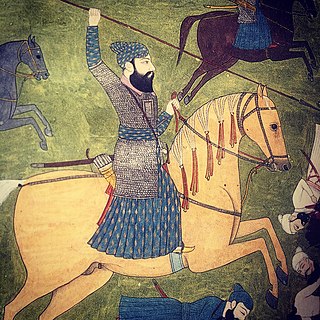This article has multiple issues. Please help improve it or discuss these issues on the talk page . (Learn how and when to remove these template messages)
|
| Battle of Gurdas Nangal | |||||||||
|---|---|---|---|---|---|---|---|---|---|
| Part of Mughal–Sikh Wars | |||||||||
| |||||||||
| Belligerents | |||||||||
| Commanders and leaders | |||||||||
| Strength | |||||||||
| 1,250 [2] | 35,000 [3] | ||||||||
| Casualties and losses | |||||||||
| 300 dead 750 captured | Unknown | ||||||||
| History of India |
|---|
 |
| Timeline |
The Battle of Gurdas Nangal took place in April 1715 between the Sikhs, led by Banda Singh Bahadur, and the Mughal Army, led by Abd al-Samad Khan. Banda, at that time was carrying out operations and small raids to the north of Amritsar. During these operations, the Mughal Army confronted the Sikhs. When confronted, the Sikhs moved northward taking shelter in the fort of Gurdaspur. It had been recently extended to accommodate 60,000 horses, and stores of food, grain and fodder had also been collected there. The Mughal Army converged upon the fort from three sides. The Delhi force of 20,000 men under Qamar-ud-din Khan advanced from the east. The Governor of Lahore’s troops, consisting of 10,000 men under Abd al-Samad Khan, marched from the south. Finally, Jammu troops numbering nearly 5,000, under Zakariya Khan, approached from the north. To the west of the fort was the River Ravi, which had no bridge over it. All the boats had been withdrawn to the opposite bank, which was closely guarded by numerous local chiefs and Mughal government officials. The Mughal pursuit made it so the Sikhs could not enter the fort at Gurdaspur. Thus, the Sikh army quickly turned west.[ citation needed ]
Due to all escape routes being barred, Banda Bahadur and his army rushed into the haveli of Duni Chand, which had a large open compound with a wall around it, at the village of Gurdas Nangal, 6 km to the west of Gurdaspur. In it, Banda accommodated 1,250 men along with a small number of horses.
The Sikhs dug a ditch around the enclosure and filled it with water from the canal flowing nearby. The Mughals also dug trenches all around the enclosure. The battle then commenced at the beginning of April 1715. The news of the battle reached Farrukhsiyar on 17 April 1715. The siege lasted a little over eight months. The whole summer from April to June, the entire rainy season from July to September, and half of winter from October to the beginning of December passed during the siege, with frequent sorties and occasional skirmishes.
Muhammad Qasim, a Mughal soldier who fought against the Sikhs in this campaign, wrote:
The brave and daring deeds of the infernal Sikhs was wonderful. Twice or thrice everyday some forty or fifty of the black-faced Sikhs came out of their enclosure to gather grass for their cattle, and, when the combined forces of the Mughals went to oppose them, they made an end of the Mughals with arrows, muskets and small swords, and disappeared. Such was the terror of the Sikhs and the fear of the sorceries of the Sikh Chief that the commanders of this army prayed that God might so ordain things that Banda should seek his safety in flight from the Garhi.
Eventually, the supplies of foodstuffs and fodder dwindled. All animals perished, and their flesh was eaten. Next, their bones and the bark of trees were powdered and eaten. Many Sikhs died of hunger and the rest were completely famished and reduced to a skeletal appearance. Seeing that resistance had completely ceased, the Mughal Army on 7 December 1715, ventured into the enclosure. About 300 Sikh men, all on the verge of death, were beheaded. Their bodies were then cut up in search of gold coins which the Mughal army believed that they had swallowed. Banda was then, along with his 750 followers, captured and taken to Delhi for execution.
| Item | Quantity |
|---|---|
| Swords | 1000 |
| Shields | 278 |
| Small Kirpans | 217 |
| Matchlocks | 180 |
| Bows and Quivers | 173 |
| Daggers | 114 |
| Silver Rupees | 600 |
| Gold Mohars | 23 |
| Gold Ornaments | 11 |










